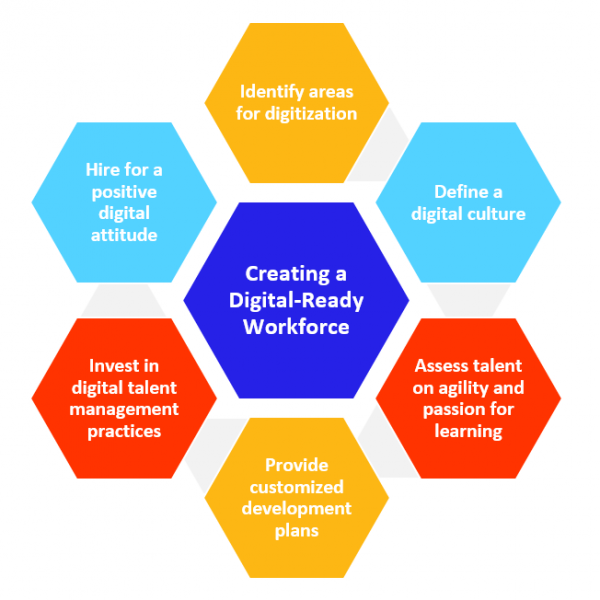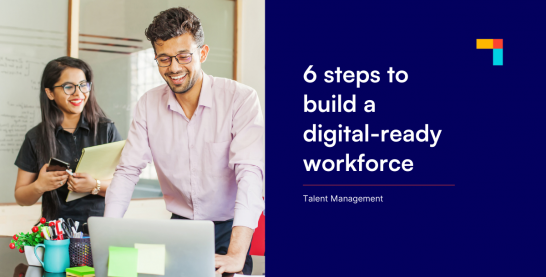The rapid pace of technological innovation and digital transformation has significantly impacted the workforce across industries. The rise of automation, artificial intelligence, and other advanced technologies has led to a growing demand for employees with digital skills and competencies. As a result, companies must have a digital-ready workforce to stay competitive and thrive in the digital age.
Leaders play a critical role in building a digital-ready workforce. They need to focus on identifying the essential digital skills and competencies for success and provide employees with opportunities to develop and refine these skills. Additionally, leaders must foster a continuous learning and adaptability culture, where employees are encouraged to embrace new technologies and work approaches.
The benefits of having a digital-ready workforce include increased productivity, enhanced innovation, and improved customer experiences. In addition, by prioritizing developing digital skills and competencies, leaders can position their organizations for long-term success in the digital era. Let’s discuss the various steps leaders can take to create a digital-ready workforce.
How to create a digital-ready workforce?
Leaders must create a digital-ready workforce prepared to embrace new technologies and drive innovation. In addition, leaders must be agile in accepting change and ensuring that the latest updates and technologies are available for employees. HR plays a pivotal role in identifying, implementing, and maintaining business operations in this regard.
A digital-first workplace is essential for any industry to thrive, and it is up to leaders to create a culture that values and prioritizes digital transformation. Some steps that can be taken to achieve this objective are:
- Identify areas for digitization: Identifying areas that can be digitized is crucial in building a digital-ready workforce. This can help leaders understand the skills and competencies required for a successful digital transformation. In addition, leaders should evaluate the current processes, systems, and technology to identify areas for digitization.
- Define a digital culture: Building a digital culture requires a top-down approach, where leaders define and drive the culture of continuous learning and adaptability to new technologies. This will ensure the entire company is aligned towards the same goals and values, enabling a smoother digital transformation process.
- Assess talent on agility and passion for learning: Along with technical skills, leaders must assess current and prospective talent on their agility and passion for learning. This will ensure that employees are equipped to adapt to new technologies and approaches to work and receptive to a culture of continuous learning and development.
- Provide customized development plans: Providing customized development plans for employees is essential to building a digital-ready workforce. This includes self-paced and instructor-led courses, mentoring, coaching, stretch assignments, and experiential learning. These plans should focus on building both technical and business skills required for digital transformation.
- Invest in digital talent management practices: Automating critical HR processes and investing in digital talent management practices can enhance HR efficiency, performance, and customer experience. This can include systems for recruitment, onboarding, performance management, and employee engagement.
- Hire for a positive digital attitude: Hiring the right people with a positive digital attitude or those who can be trained and coached to adopt technology as a way of life is critical. Leaders must focus on in-house development more than buying talent from outside unless the skills are critical. This approach can help build a culture of digital readiness and facilitate a smoother digital transformation process.

How to Avoid Problems Caused While Preparing a Digital-Ready Workforce?
Preparing a digital-ready workforce involves taking several precautions to ensure success in the transformation process.
- Firstly, it is essential to provide adequate training and upskilling to employees and managers to use new platforms and applications efficiently. This involves creating customized development plans that include self-paced and instructor-led courses, mentoring, coaching, and experiential learning.
- Secondly, the transformation process requires a change of mindset and culture and should be managed through a strategic change management process. Finally, communication of the benefits of digital transformation at all levels is crucial in creating employee champions who can help carry the message across the organization.
- Thirdly, it is vital to ensure that automating processes is not the only focus of digital transformation. As a result, there is a need to identify areas that can be digitized and prioritize implementing digitization initiatives.
- Lastly, it is crucial to remember that digital transformation is an ongoing process, and continuous support is necessary to help employees learn to leverage new technologies. With these precautions, leaders can prepare the workforce to be digital-ready and thrive in an ever-evolving industry.
Section Summary
- Upskilling through customized development plans, mentoring, coaching, and experiential learning.
- Strategic change management processes, communication, and creating employee champions are essential for digital transformation.
- Focus on identifying areas to digitize, not just automation of processes. Continuous support is necessary for employees to learn and leverage new technologies.
- Digital readiness is an ongoing process. Therefore, precautions must be taken to manage the cultural and mindset shift during the digital transformation.
Companies must adopt a top-down approach to driving and defining the digital culture, assess current and prospective talent on agility and passion for learning, and provide customized development plans to upskill their employees. Additionally, targeted interventions should be adopted to help employees learn new technologies, and HR processes should be automated to enhance HR efficiency and customer experience.
Before you go..
It is essential to take precautions to ensure successful digital transformation, such as providing adequate training, communicating the benefits of the transformation, and prioritizing the implementation of digitization initiatives. With these strategies in place, leaders can prepare their workforce for the digital age and thrive in the future.

